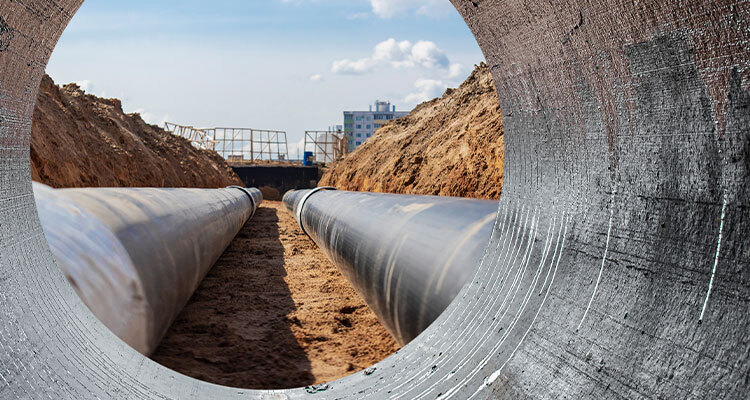Given how rapidly tech innovation in construction is evolving, Tracy Buelow shares her expertise on the latest industry trends for businesses to stay ahead in 2024
For those in construction, there is reason for optimism in 2024, particularly with demand expected to stay high in certain segments. To get the biggest benefits from these increases and stay ahead of market pressures, remaining up to date on industry trends is essential. In this article, we’ll review the 2024 market landscape and explore three of the top construction industry trends to watch this year, including tech and digitization, the continued rise of material costs, and why builders are more apt to choose advanced materials over traditional ones.
2024’s market landscape

This year, we predict that high industry demand will continue, especially when it comes to the public sector. For example, Deloitte found that the Associated Builders and Contractors (ABC) expect an increase in overall profit margins for the first half of 2024, which would help support continued growth and according to the Associated General Contractors of America; there is a lot of anticipation around water and sewer projects, transportation, federal, and bridge and highway work.
However, this optimism is tempered with concerns over high interest rates reducing the appetite for construction in some areas, ongoing supply chain delays, the shortage of skilled labor and increased material prices. Despite these concerns and challenges, you can boost your business by preparing for some of the top construction trends you’re sure to come across this year no matter what project you’re tackling.
Continued rise of material costs
The uncertainty around cost and resultant potential cost overruns can put entire projects in jeopardy. Even though these conditions are unlikely to resolve themselves in the near-term, businesses can mitigate their risk using established project management methods, including planning and budgeting. The industry has also turned to ecommerce sites to purchase materials, shorten project schedules, and lower costs. A few project management steps you can take to help reduce costs include:
- Maintaining accurate estimates, for example by pricing components out in advance and including a buffer for contingencies
- Managing the job site to ensure that all material usage is tracked
- Ensuring consistent communications with the client to let them know when costs or plans change
While individual projects differ substantially and come with their own unique challenges, finding smart and effective ways to manage these projects is critical to meeting deadlines and budgets, as well as growing your business. Focus on developing a strategic approach that has core principles around communication and collaboration. Also look for the right tools to help understand costs, like construction calculators, which can be a simple and easy way to accurately understand and manage costs.
 Tech and digitization in construction
Tech and digitization in construction
Another important way to manage costs and remain competitive is to stay up to date on the latest trends and integrate new technologies into operations. Building on the theme of project management, the industry is growing rapidly and adopting and implementing new tech including artificial intelligence, visual intelligence and design tools and other innovative devices. AI in particular can be a huge advantage for construction firms and businesses. For example, it can be used to help prioritize tasks, identify dependencies, and improve efficiencies. It can also help predict cost overruns by crunching historical data, analyze 3D scans of a site to fully understand the true project status or identify potential issues so your team can work to resolve them earlier.
Sensors, drones, Internet of Things (IoT) devices, robotics, immersive collaboration, and 3D printing are a few other emerging technologies that are pushing construction boundaries. These types of tech can be used to not only increase productivity, enhance safety and allow companies to further its scalability, they can also help track project progress in real time and communicate with all involved parties of any issues or pending risks.
Creating sustainable designs
In addition to using new technologies, the use of advanced construction materials can help meet project requirements while providing benefits such as a reduced carbon footprint, fewer emissions and less waste. With new regulations and a continued focus on sustainability, customers are increasingly more likely to place pressure on developers to find more sustainable methods of construction.
One great way to support sustainable design is to choose products that are reusable and reconfigurable because they can be adapted in the case of future changes. According to Hubbell Wiring Systems, some sustainable materials could include:
- Modular systems that are reusable and reconfigurable to accommodate potential future changes to the design and reduce waste associated with needing to be replaced.
- Products with similar longevity to the building itself to reduce the change of them needing to be replaced and causing additional waste.
- Products with minimal packaging and are not created with hazardous materials like lead, mercury, cadmium, hexavalent chromium, etc.
Navigating the future of construction
Whether its cost management, increased efficiency, better risk mitigation or improved sustainability and safety, these trends show no slowing down in 2024. When addressed proactively, these trends not only allow the business to remain competitive but can also help reduce cost and improve profitability for years to come.
Tracy Buelow
www.zoro.com
Tracy Buelow serves as the Vice President, Category Management at Zoro.com, which is an ecommerce business, providing supplies, equipment, and tools to help its customers find exactly what they need to develop and maintain a successful business. The company, a Grainger subsidiary, continues to upgrade its offerings and services to make it easy and seamless for contractors and businesses alike to get the materials they need.
